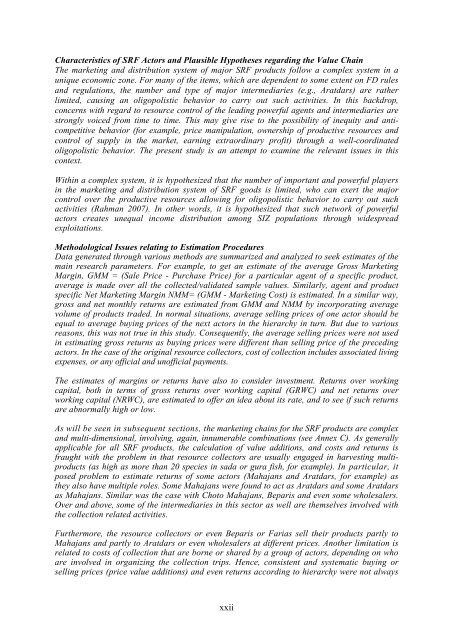INTEGRATED PROTECTED AREA CO-MANAGEMENT (IPAC) - BIDS
INTEGRATED PROTECTED AREA CO-MANAGEMENT (IPAC) - BIDS
INTEGRATED PROTECTED AREA CO-MANAGEMENT (IPAC) - BIDS
You also want an ePaper? Increase the reach of your titles
YUMPU automatically turns print PDFs into web optimized ePapers that Google loves.
Characteristics of SRF Actors and Plausible Hypotheses regarding the Value Chain<br />
The marketing and distribution system of major SRF products follow a complex system in a<br />
unique economic zone. For many of the items, which are dependent to some extent on FD rules<br />
and regulations, the number and type of major intermediaries (e.g., Aratdars) are rather<br />
limited, causing an oligopolistic behavior to carry out such activities. In this backdrop,<br />
concerns with regard to resource control of the leading powerful agents and intermediaries are<br />
strongly voiced from time to time. This may give rise to the possibility of inequity and anticompetitive<br />
behavior (for example, price manipulation, ownership of productive resources and<br />
control of supply in the market, earning extraordinary profit) through a well-coordinated<br />
oligopolistic behavior. The present study is an attempt to examine the relevant issues in this<br />
context.<br />
Within a complex system, it is hypothesized that the number of important and powerful players<br />
in the marketing and distribution system of SRF goods is limited, who can exert the major<br />
control over the productive resources allowing for oligopolistic behavior to carry out such<br />
activities (Rahman 2007). In other words, it is hypothesized that such network of powerful<br />
actors creates unequal income distribution among SIZ populations through widespread<br />
exploitations.<br />
Methodological Issues relating to Estimation Procedures<br />
Data generated through various methods are summarized and analyzed to seek estimates of the<br />
main research parameters. For example, to get an estimate of the average Gross Marketing<br />
Margin, GMM = (Sale Price - Purchase Price) for a particular agent of a specific product,<br />
average is made over all the collected/validated sample values. Similarly, agent and product<br />
specific Net Marketing Margin NMM= (GMM - Marketing Cost) is estimated. In a similar way,<br />
gross and net monthly returns are estimated from GMM and NMM by incorporating average<br />
volume of products traded. In normal situations, average selling prices of one actor should be<br />
equal to average buying prices of the next actors in the hierarchy in turn. But due to various<br />
reasons, this was not true in this study. Consequently, the average selling prices were not used<br />
in estimating gross returns as buying prices were different than selling price of the preceding<br />
actors. In the case of the original resource collectors, cost of collection includes associated living<br />
expenses, or any official and unofficial payments.<br />
The estimates of margins or returns have also to consider investment. Returns over working<br />
capital, both in terms of gross returns over working capital (GRWC) and net returns over<br />
working capital (NRWC), are estimated to offer an idea about its rate, and to see if such returns<br />
are abnormally high or low.<br />
As will be seen in subsequent sections, the marketing chains for the SRF products are complex<br />
and multi-dimensional, involving, again, innumerable combinations (see Annex C). As generally<br />
applicable for all SRF products, the calculation of value additions, and costs and returns is<br />
fraught with the problem in that resource collectors are usually engaged in harvesting multiproducts<br />
(as high as more than 20 species in sada or gura fish, for example). In particular, it<br />
posed problem to estimate returns of some actors (Mahajans and Aratdars, for example) as<br />
they also have multiple roles. Some Mahajans were found to act as Aratdars and some Aratdars<br />
as Mahajans. Similar was the case with Choto Mahajans, Beparis and even some wholesalers.<br />
Over and above, some of the intermediaries in this sector as well are themselves involved with<br />
the collection related activities.<br />
Furthermore, the resource collectors or even Beparis or Farias sell their products partly to<br />
Mahajans and partly to Aratdars or even wholesalers at different prices. Another limitation is<br />
related to costs of collection that are borne or shared by a group of actors, depending on who<br />
are involved in organizing the collection trips. Hence, consistent and systematic buying or<br />
selling prices (price value additions) and even returns according to hierarchy were not always<br />
xxii














